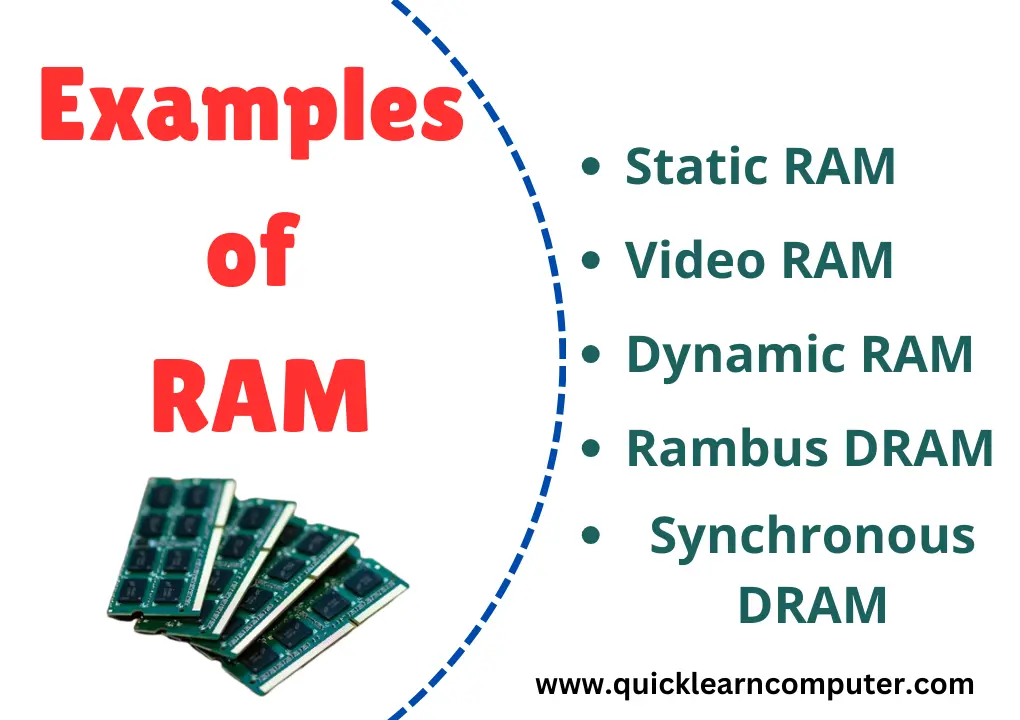Random Access Memory (RAM) is a main component of computing device. It provides temporary storage that allows the processor to quickly access data required for running applications and processes.
Without RAM, a computer would be significantly slower, relying only on storage drives like HDDs or SSDs, which are much slower in comparison.
Note – The only purpose of this article is to tell you about 10 examples of RAM in very simple language. This article has been written by an expert person. If you think this article can be improved further then you must give us feedback.
Examples of RAM Memory
There are various examples of RAM Memory, which are given below.

1. SRAM (Static RAM)
SRAM is a type of RAM that retains data as long as power is supplied. Unlike DRAM, it does not require constant refreshing, making it faster and more efficient for specific applications.
Features:
Faster access times than DRAM.
More expensive to manufacture.
Used in CPU cache memory and high-speed applications.
2. DRAM (Dynamic RAM)
DRAM is the most common type of RAM found in personal computers and laptops. It requires constant refreshing to retain data, which makes it slightly slower than SRAM but more cost-effective.
Features:
Higher storage capacity than SRAM.
Requires periodic refreshing.
Used in main memory (system RAM) of computers.
3. SDRAM (Synchronous DRAM)
SDRAM is an improvement over traditional DRAM, synchronized with the system clock for better efficiency.
Features:
Works in sync with the CPU clock.
Higher speeds compared to traditional DRAM.
4. DDR RAM (Double Data Rate RAM)
DDR RAM has evolved through multiple generations, improving performance and power efficiency.
Examples of DDR RAM:
DDR1: Older generation, slower compared to modern standards.
DDR2: Improved speed and lower power consumption.
DDR3: Increased bandwidth and efficiency.
DDR4: Faster speeds and improved reliability.
DDR5: Latest generation with even higher speeds and power efficiency.
5. GDDR (Graphics Double Data Rate) RAM
GDDR RAM is optimized for graphical processing, commonly found in GPUs.
Features:
Higher bandwidth than standard DDR RAM.
Used in gaming graphics cards and professional GPUs.
Versions include GDDR3, GDDR4, GDDR5, GDDR6, and GDDR6X.
6. VRAM (Video RAM)
VRAM is specifically designed to store image and video data for quick access by the GPU.
Features:
Helps improve graphics rendering speed.
Used in dedicated graphics cards for gaming and professional applications.
Often integrated into modern GPUs.
7. ECC RAM (Error-Correcting Code RAM)
ECC RAM is used in high-end workstations and servers where data integrity is critical.
Features:
Detects and corrects memory errors automatically.
Used in enterprise and mission-critical computing.
More expensive than standard RAM.
8. LPDDR (Low Power DDR) RAM
LPDDR is a type of DDR RAM designed for mobile devices.
Features:
Lower power consumption compared to standard DDR RAM.
Found in smartphones, tablets, and Ultrabook.
Versions include LPDDR3, LPDDR4, LPDDR5.
9. RDRAM (Rambus DRAM)
RDRAM was an alternative to SDRAM and DDR but lost popularity due to cost and competition.
Features:
Used in some older gaming consoles and high-end PCs.
High latency and expensive compared to DDR.
10. Cache Memory (L1, L2, L3)
Although not traditionally considered RAM, cache memory plays a crucial role in speeding up computing processes.
Features:
L1 Cache: Closest to the CPU, extremely fast but small in size.
L2 Cache: Larger than L1 but slightly slower.
L3 Cache: Shared among cores, improves overall CPU performance.
Conclusion
RAM is an essential hardware component of computing, with different types designed for various applications.
From SRAM for cache memory to GDDR for gaming graphics cards, understanding RAM types helps in making informed decisions for upgrading or purchasing new devices.
Whether you are building a gaming PC, upgrading a server, or selecting a smartphone, knowing the right RAM type can significantly impact performance and efficiency.
FAQS
RAM is used as a short memory because it is?
RAM is used as a short memory because it is Volatile Memory. Every computer system has volatile memory, which is capable of reading and writing any data very fast.
RAM is example of which memory?
RAM is the example of Primary Memory.
RAM is temporary memory?
Yes, RAM is temporary memory because RAM is a volatile memory that cannot save any data permanently.